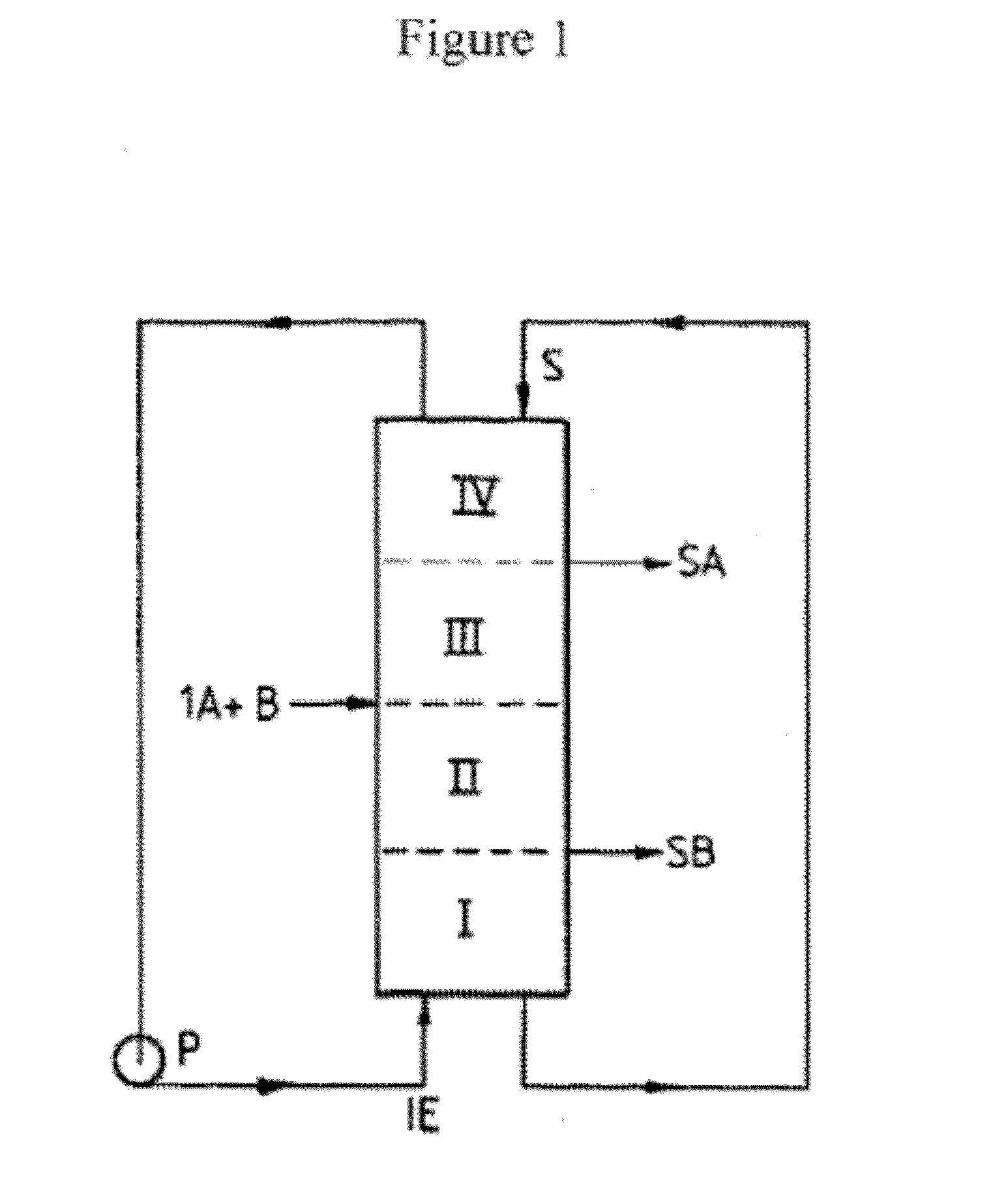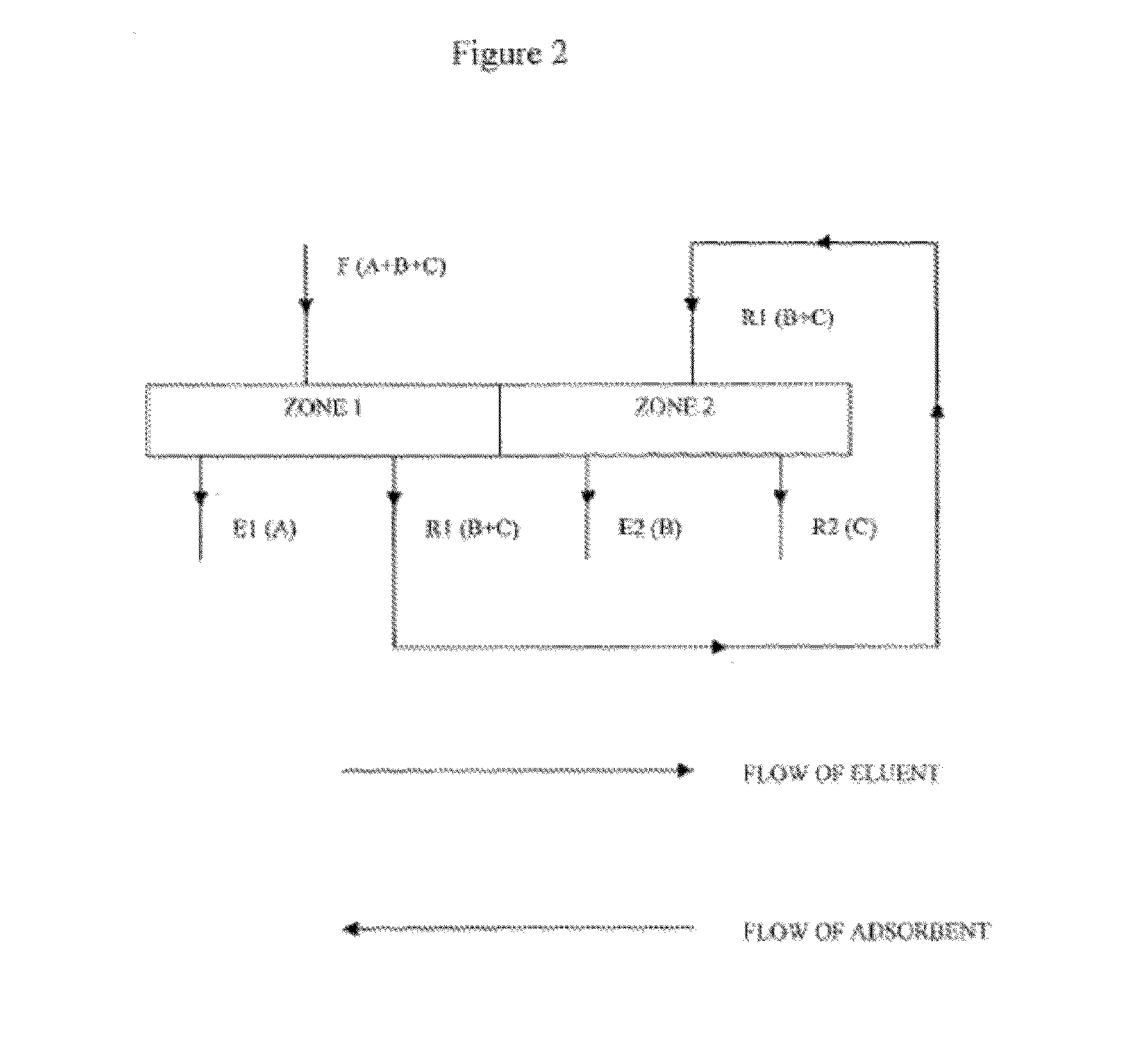Purification of long chain diacids
a technology of diacid and long chain, which is applied in the preparation of carboxylic compounds, separation processes, ion-exchangers, etc., can solve the problems of low molecular weight polymers, low dyeability, and the content of color-inducing impurities that may react under high temperatur
- Summary
- Abstract
- Description
- Claims
- Application Information
AI Technical Summary
Benefits of technology
Problems solved by technology
Method used
Image
Examples
example 1
HPLC Tests
[0140]A 10 μL volume of feed mixture comprising a diacid, a monocarboxylic acid, and a hydroxyl acid in methanol, each at a concentration of 10 mg / mL, was injected into an HPLC column containing a stationary phase adsorbent of 5 μm particle size and 120 Å pore size. An aqueous methanol eluent (i.e., mobile phase) was then fed at a flow rate of 1 mL / min to the HPLC column (model HP-1100) operating at a set temperature. The eluent stream leaving the column was analyzed by continuous UV detection at 220 nm to determine the concentrations and retention times of the diacid, mono carboxylic acid, and hydroxyl acid species.
[0141]In examples 1a-1c, the diacid was adipic acid (AA), the monocarboxylic acid was caproic acid (CA), and the hydroxyl acid was 6-hydroxycaproic acid (6-HCA). In examples Id-le, the diacid was dodecandioc acid (DDDA), the monocarboxylic acid was lauric acid (LA), and the hydroxyl acid was 12-hydroxydodecanoic acid (12-DDA).
[0142]Specific feed mixture compone...
example 2
Pulse Tests
[0143]An aqueous methanol eluent (i.e., mobile phase) of methanol:water volumetric ratio varying from 95:5 to 80:20 vol:vol was fed at flow rate of 5 mL / min to a column of 10 mm diameter by 250 mm length, packed with Orpheus ADS adsorbent particles of 250-500 μm particle diameter, and maintained at 60° C. temperature. The mass of the adsorbent was approximately 12 g. The eluent flow was temporarily stopped, a 5 mL volume pulse of feed mixture was injected into the column, the eluent flow was restarted at a flow rate of 5 mL / min, the eluent leaving the column was collected as a series of 5 mL samples every 1 minute, and the samples were analyzed by mass spectrometer (API 3000 LC-MS / MS) to determine concentrations of the acid components as a function of time since feed injection.
[0144]In example 2a, the feed mixture composition was 10 wt % AA, 5 wt % 6-HCA, and 5 wt % CA in methanol; the adsorbent was Orpheus ADS2-equivalent (C18 22% C in FIG. 11; Polar C18 in FIG. 12); and...
example 3
SMB Separation of C6 Diacid
[0145]An aqueous feed mixture comprising 10 wt % adipic acid (AA), 0.5 wt % 6-hydroxycaproic acid (6-HCA), and 0.5 wt % caproic acid (CA) is fed at a flow rate of 145,874 to a SMB unit comprising 15 columns and operating at 37° C. Each column contains an adsorbent bed 4 m in diameter by 4 m in height of Orpheus ADS2 non-polar silica-based stationary phase adsorbent of 250 urn particle size and 120 Å pore size, available from Orochem Technologies Inc., Naperville, Ill., USA. A methanol desorbent (mobile phase) is fed to the SMB unit at a flow rate of 52,083 kg / hr. An extract is withdrawn from the SMB unit at a flow rate of 40,968 kg / hr. A raffinate is withdrawn from the SMB unit at a flow rate of 156,989 kg / hr.
[0146]At a time t, the aqueous feed mixture is fed to column 10, the methanol desorbent is fed to column 1, the extract is withdrawn from column 6, and the raffinate is withdrawn from column 14. Periodically, according to a step time, dt, the inlet an...
PUM
| Property | Measurement | Unit |
|---|---|---|
| height | aaaaa | aaaaa |
| height | aaaaa | aaaaa |
| height | aaaaa | aaaaa |
Abstract
Description
Claims
Application Information
 Login to View More
Login to View More - R&D
- Intellectual Property
- Life Sciences
- Materials
- Tech Scout
- Unparalleled Data Quality
- Higher Quality Content
- 60% Fewer Hallucinations
Browse by: Latest US Patents, China's latest patents, Technical Efficacy Thesaurus, Application Domain, Technology Topic, Popular Technical Reports.
© 2025 PatSnap. All rights reserved.Legal|Privacy policy|Modern Slavery Act Transparency Statement|Sitemap|About US| Contact US: help@patsnap.com



